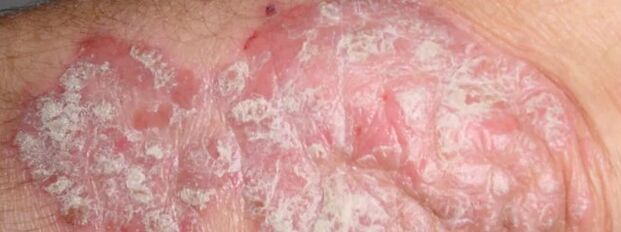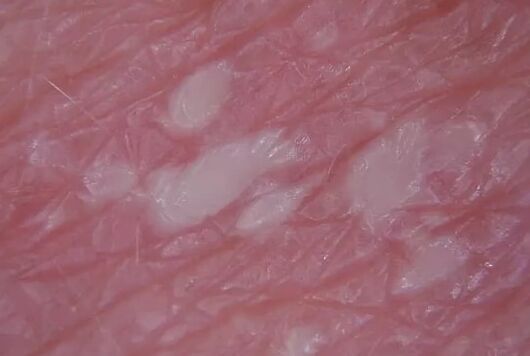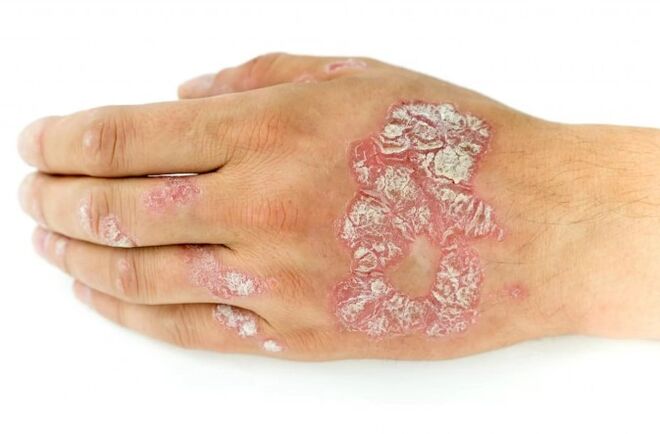Psoriasis is a chronic dermatological disease, the basis of the pathogenesis of which is abnormally rapid growth of the skin cells, which leads to the appearance of the surface of the skin of sealed areas of different colors.
Today, psoriasis has become the most common dermatological disease that is not infectious.Psoriasis has no gender predisposition - both men and women suffer from them equally often.You can get this pathology at any age, but more often the first signs of the disease appear up to 20 years.

Psoriasis is quite bad in therapy, partly due to the fact that the etiology and pathogenesis of this pathology are not yet clear.In addition, there is no means of specific prevention of psoriasis, as it is impossible to determine whether a person is predisposed to the disease.
The reasons for the development
Currently, scientists cannot unequivocally answer the question "Why is psoriasis developing?"There are two main factors of the development of the disease - this is the genetic predisposition and hyperreactivity of the immunity system.
It has been established to dateThe predisposition to the development of psoriasis is hereditarySBut the difficulty lies in the fact that it is extremely difficult to track exactly how this predisposition is inherited and after the influence of which factors psoriasis can develop.
The following factors are thought to cause the development of psoriasis:
- Frequent skin hypothermia as well as the effect of dry climate on it;
- Infectious processes;
- Frequent tensions;
- The use of some groups of pharmaceuticals: non -steroidal anti -inflammatory drugs (especially aspirin), some hypotonic and psychotropic drugs;
Pathogenesis
Currently, the pathogenesis of psoriasis has not been finally understood.Two main connections of pathogenesis can be distinguished:
- Disruption of keratinization of the skin.
- Disruption of the immunity system.
Together, the above factors lead to the fact that the cells of the lower layers of the epidermis for an unknown reason begin to share very quickly.This process leads to a reactive increase in the rate of drying of the upper layer of epidermal cells, which is manifested externally by peeling the skin.
Symptoms
The disease always begins acutely, without any enterprises for the development of the pathological process.As a rule, the first elements of the rash are located at the point where the skin was damaged.
At the beginning of the symptoms of psoriasis papules of pink or red colors appear on the skin.This process is accompanied by itching.The size of the elements varies from several millimeters to 1.5 centimeters (in some cases the elements reach even large sizes).Then the rash elements are covered with easily separated silver flakes.
Sometimes psoriasis damages nail plates.This pathology looks like fungal nail damage and is manifested by the following symptoms:
- There are very small indentations on the surface of the nail;
- The edge of the nails thickens and turns a dull, yellowish color;

Another characteristic manifestation of psoriasis is psoriatic arthritis (symmetrical damage to the joints and periarticular tissues).Most often, the pathological process develops in the interphalaced joints of the legs and arms.Initially, the disease is manifested by pain and swelling and then deformation of the affected joint develops, which can even lead to damage to the patient.It should be noted that in rare cases damage is also possible.Sometimes psoriatic arthritis develops even in the joints of the spine.
Types
The following types of psoriasis are distinguished depending on the severity and characteristics of the clinical manifestations:
- Plaquaper.This type is the most common - it is diagnosed in almost 90% of people suffering from psoriasis.Theoretically, the rash elements can appear in any area of the skin.However, the most typical locations are the lower back, scalp and extensors of the upper and lower limbs (elbow and knee area).It should be noted that with this form of psoriasis, pathological elements do not appear on the face, palms and soles remain intact.Externally, this shape looks like an inflamed plaque covered with silver with flakes.When the plaques are displayed under the rock, lymph is released.With a more injury, the plaque begins to bleed.The shape of the psoriasis plaque is also characterized by the appearance of the so -called "paraffin lakes" - the merger of several plaques into one element.
- Back psoriasis (psoriasis on flexion surfaces or inter -trigger).This shape is quite rare.The rash elements have the shape of red spots without peeling that do not protrude above the surface of the intact skin.Typical localization of this form of psoriasis - skin folds (axillary cavities, inguinal folds, skin under the breasts in women).Also, due to the characteristics of location, fungal infection often joins the reverse psoriasis.
- Genital psoriasis.This form most often develops in girls, mainly in adolescence (up to 16 years).Often the development of the pathological process is preceded by streptococcal infection (eg angina).Rocky psoriasis rashes look like a simple allergic rash - small dots that have a gray to lilac color, not protruding above the surface of the skin.Such rashes can occur in any area of the skin.The skin on which the rashes are located is generally an inflamed appearance.
- Pustulenia psoriasis.This is a tighter shape than the above.With pustular psoriasis, small painful pus, filled with pus, appear on the patient's body.This form can occur both locally and generally.With pustular psoriasis, the general condition of patients often deteriorates, body temperature increases.The generalized form of pustular psoriasis requires hospitalization.
- Erythroderma is the most severe form of psoriasis.With it, almost all the skin of the patient is damaged.This form is accompanied by chills, fever to a large number, a sharp deterioration in the patient's condition.This disease requires emergency medical intervention, in the absence of a fatal result it can even occur.

Weight
There are many different gradations of psoriasis in terms of weight.However, in routine clinical practice, the simplest of them is most often used, which does not require special methods of examination.
Thus, distinguishThree degrees of weight of psoriasisDepending on the spread of the pathological process:
- Light shape.This form is placed in cases where the patient is affected by psoriasis below 3% of the skin.
- Moderate form.This diagnosis is made with impairment of psoriasis from 3 to 10% of the patient's skin.
- Heavy form.This form is exposed taking into account the skin lesion and clinical manifestations.In this way, this form is exposed with a lesion over 10% of the skin or with a significant deterioration in the patient's well.It should be noted that psoriasis is considered severe in the presence of psoriatic arthritis, regardless of the degree of spread of the pathological process.
The course of the disease and the prognosis
Psoriasis is a disease with a wave -like course, that is, there are periods of remission (when the symptoms virtually disappear) and exacerbation.As a rule, the process worsens during the periods of the season.
The prognosis for psoriasis depends on the form of the disease and the severity.As a rule, with classic forms of psoriasis, the prognosis is favorable, but in severe forms it is possible to damage and even death.
Despite the favorable prognosis in most forms of psoriasis, do not forget about the social aspect of this disease.In the acute period of disease, the skin and the hair of the human head are covered with peeling plaques, which are often perceived by others as a manifestation of any contagious disease.Therefore, those around them begin to deviate from the patient, which causes him to be closed and often depression.
Diagnostics

The basis for diagnosis is the clinical manifestations of the disease, The characteristics of its current, as well as the data of the objective verification.There are a number of characteristic symptoms that are determined to diagnose psoriasis:
- "Psoriatic film" - if you are cleaning the surface of the peeling papule, then it becomes smooth and shiny.
- Stearin Stain - When psoriatic elements are displayed, their surface becomes whitish, Starin films appear.
- "Blood dew" - if after the manifestation of the above symptoms do not stop the sling of the elements, then their surface is covered with droplets of blood (capillary bleeding occurs).
Three symptoms described above are called "psoriatic triad" and are the main method of diagnosing psoriasis.However, there are a few more signs that are determined at a certain stage of the disease:
- In the acute stage of psoriasis, symptoms of chicken (psoriatic elements are surrounded by a red edge) and kebner (new rashes actively appear in damaged areas of the skin).
- The stages of regression also determine the symptom of Voronov (around the elements a shiny light edge of a little wrinkled skin is determined).
The following is used by laboratory and instrumental methods:
- Microscopy of flakes and dough with potassium hydroxide (for differential diagnosis with fungal skin damage).
- In complex clinical cases, with an atypical course, pathological elements resort to a biopsy.
- Psoriatic arthritis examines blood test indicators (mainly ESR and rheumatoid factor) and conduct the X -s) of the affected joints (for differential diagnosis with arthritis of another etiology).

Treatment
Treatment for psoriasis is a long and complex process.Unfortunately, since psoriasis is a chronic disease, the purpose of therapy is not the treatment of the patient, but to achieve prolonged remission and prevent exacerbations.Treatment depends on the stage, shape and severity of psoriasis.It should be noted that a set of medical measures should be prescribed by a dermatologist and only after a thorough examination of the patient and checking the diagnosis.
Diet.Treatment for psoriasis should begin with the correction of the patient's daily diet.If we are talking about general recommendations, then people with psoriasis should reduce the amount of protein in the diet and increase the amount of carbohydrates due to the consumption of vegetables and fruits.It is also necessary to exclude those products that can provoke exacerbation of psoriasis: alcohol, chocolate, various spicy spices, and to limit the use of garlic and onions.It is also worth limiting the consumption of fried meat and fish, smoked meats.
In addition, when compiling an optimal diet, the patient's predisposition to allergies to any products and, if possible, should be taken into account.The optimal diet is to use a large amount of fresh and vegetables and slender varieties of meat and fish in cooked form.
Treatment with medicines.For the treatment of psoriasis, pharmaceuticals are used in various forms of release: ointments, tablets, injections and more.
In addition to local medicines, systemic therapy is also used when medicines are prescribed in the form of tablets or injections.The following medicines are most often prescribed:
- Immunosuppressants.They have a huge effect on the immunity system.It is prescribed only in severe cases that are not subject to other methods of therapy, as it has a large number of side effects and is difficult to transfer.
- Cytostatics.Its action is aimed at reducing the rate of cell division, which leads to a decrease in the rate of development of psoriasis and a decrease in peeling.It is only used in very severe cases, with resistance to other methods of therapy.
- Various homeopathic remedies.Unfortunately, these drugs are not suitable for all patients and do not always have the necessary effect.

Photohemotherapy.Lighting is one of the main methods of psoriasis therapy.
In conclusion, it is worth noting that psoriasis is complex and not fully studied disease.A qualified doctor should be performed by treatment.Remember that no miraculous methods praised on the Internet will help you get rid of psoriasis.
The same can be said for folk medicine - all its methods will only benefit in combination with the basic medicines that the attending physician has prescribed.
In this way, we can conclude that in order to succeed in treatment, the patient should only use those methods that he agrees with his doctor, and to monitor all his recommendations.This is the only way to achieve good success in treatment and prolonged remission of psoriasis.























